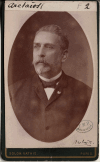Maxillofacial Surgery Within the Archive of the Greek Surgeon of the 19th Century Theodoros Aretaios (1829-1893)
- PMID: 39712816
- PMCID: PMC11663237
- DOI: 10.7759/cureus.74195
Maxillofacial Surgery Within the Archive of the Greek Surgeon of the 19th Century Theodoros Aretaios (1829-1893)
Abstract
One of the most important figures of the Hellenic surgery of the 19th century, professor of the Othonian University of Athens, Theodoros Aretaios (1829-1893), portrays in his personal archives a series of surgical operations in the field of maxillofacial surgery. During his career, he operated the following surgical diseases, these are adenosarcomas or inosarcomas of the parotid region, osteofibroma of the sinus antrum, osteosarcomas of the upper and lower jaw, and lycostoma (cleft palate). He was able to perform radical enucleations of the tumorous masses. He reconstructed the area as a plastic surgeon. He had great surgical speed. In addition, the use of modern surgical tools, his ability to drain with catheters surgical wounds, and his skills to manipulate soft tissues, bones, and teeth, resulted in satisfactory outcomes. This historical vignette, by conducting documentary research in Theodoros Aretaios Archives, kept in the National Library of Greece, unveils one more surgical edge of a great surgeon.
Keywords: cleft palate; facial oncology; hellenic surgery; parodit gland; scirrhus.
Copyright © 2024, Filippidis et al.
Conflict of interest statement
Conflicts of interest: In compliance with the ICMJE uniform disclosure form, all authors declare the following: Payment/services info: All authors have declared that no financial support was received from any organization for the submitted work. Financial relationships: All authors have declared that they have no financial relationships at present or within the previous three years with any organizations that might have an interest in the submitted work. Other relationships: All authors have declared that there are no other relationships or activities that could appear to have influenced the submitted work.
Figures



Similar articles
-
Theodoros Aretaios (1829-1893) and the Foundation of Greek Orthopedic Surgery.Acta Med Acad. 2025 Apr;54(1):66-72. doi: 10.5644/ama2006-124.468. Acta Med Acad. 2025. PMID: 40151956 Free PMC article.
-
Highlighting the contribution of the Greek physician Theodoros Aretaios to the history of thyroidectomy.Hormones (Athens). 2024 Dec;23(4):849-855. doi: 10.1007/s42000-024-00575-6. Epub 2024 Jun 24. Hormones (Athens). 2024. PMID: 38913226 Review.
-
The Hellenic surgical School for treatment of neuralgias and dystonias as presented in 19th-20th centuries in Greece.Acta Chir Belg. 2025 Feb;125(1):69-75. doi: 10.1080/00015458.2024.2424038. Epub 2024 Nov 3. Acta Chir Belg. 2025. PMID: 39473381 Review.
-
Historical perspectives on the surgical treatment of hernias in Greece: from 18th century's attempts to late 19th century's innovations in hernia surgery.Acta Chir Belg. 2025 May 3:1-9. doi: 10.1080/00015458.2025.2499843. Online ahead of print. Acta Chir Belg. 2025. PMID: 40293289 Review.
-
Dimitrios Mavrokordatos (1811-1839), the eve of the Hellenic School of Anatomy in modern era Greece.Ital J Anat Embryol. 2015;120(3):172-8. Ital J Anat Embryol. 2015. PMID: 27086416
References
-
- Theodoros Aretaios (1829-1893) the Most Eminent Surgeon of His Era and the First Pediatric Tracheotomy Due to Laryngeal Diphtheria in Modern Greece. Kokkolatos K. Weekly Rev. 1893:507–508.
-
- Dimitriadis D. Tarousopoulos Press, Athens. Athens, Greece: Tarousopoulos Press; 1921. The benefactors of universities: Biography with images, National and Kapodistrian University of Athens.
-
- Kouzis A. Pyrsos Press, Athens. Athens, Greece: Pyrsos Press; 1837. History of the Medical School, One Hundred Years.
-
- Aretaios T. Athens, Greece: 1870. Surgery (Ἐγχειριστικῆ)
-
- Aretaios T. Athens, Greece: 1880. Surgical Pathology (Χειρουργική Παθολογία)
Publication types
LinkOut - more resources
Full Text Sources
